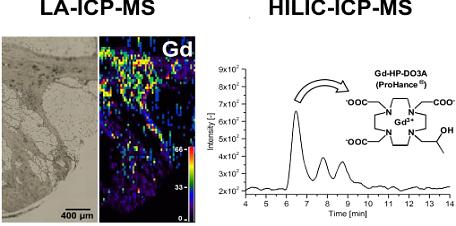German researchers from the University of Münster found intact Gd-based contrast agents in skin biopsies of an NSF patient eight years after the last administration.
Background:
Nephrogenic systemic fibrosis (NSF) is a rare disease that is only diagnosed in patients with impaired renal failure after application of Gd-based contrast agents. Characteristics of the potentially fatal disorder NSF are swelling and hardening of the skin as well as the formation of brawny thickening at the extremities. First cases of this disease were observed in 2000 and in 2006 the relationship between NSF and the administration of so-called linear GBCA to renal failure patients was proposed. In 2009, researchers proposed that transmetallation of the Gd-based contrast agent resulting in the release of free Gd3+, to be the critical process for the toxic action. However, the pathogenesis is still not completely understood.
The new study:Researchers from the University of Münster now used a unique combination of elemental bioimaging and speciation analysis to study the presence of gadolinium compounds in skin biopsy samples of a 25-year-old female with NSF symptoms.

a) Microscopic image of the investigated skin section of a NSF patient.
b) LA-ICP-MS distribution map for Gd in the same skin section
c) HILIC-ICP-MS chromatograms of the sample extract
|
Laser ablation-ICP-MS was used to map the distribution of gadolinium and other elements within the skin biopsies and microwave digestion followed by ICP-MS was used to determine the total gadolinium concentration.
The total gadolinium concentration in the tissue was found to be between 3.02 and 4.58 mg/kg for three biopsy samples. Much higher concentrations of gadolinium, namely, from 50 mg/kg to approximately 400 mg/kg, were detected in three individual areas in the tissue section of a NSF patient by LA-ICP-MS. Furthermore, a good correlation between the distributions of phosphorus and gadolinium suggests the presence of GdPO4 deposits in the tissue section.
The researchers summarized that significant Gd deposits in the tissue samples were observed even years after delivery of the contrast agent, thus allowing an unambiguous diagnosis of NSF for the patient.
The researchers then applied speciation analysis by using HILIC-ICP-MS to aqueous extracts of skin biopsies in order to look for the originally applied Gd-based contrast agents. Despite the fact that the administration of the GBCA in connection with MRI of the patient took place eight years prior to the skin biopsy, the highly sensitive technique allowed to detect the macrocyclic GBCA Gd-HP-DO3A besides two other non-identified Gd-compounds.
The authors conclude that the presence of unidentified Gd-species call for further studies regarding speciation analysis to gain information about species transformation during the course of NSF development.
 The cited study:
The cited study:

Marvin Birka, Kristina S. Wentker, Elke Lusmöller, Brigit Arheilger,
Christoph Alexander Wehe,
Michael Sperling, Rudolf Stadler, and
Uwe Karst,
Diagnosis of Nephrogenic Systemic Fibrosis by means of Elemental Bioimaging and Speciation Analysis, Anal. Chem., 87/6 (2015) 3321-3328. DOI:
10.1021/ac504488k  Used Instrumentation:
Used Instrumentation:
 Thermo Scientific iCAP QC ICP-MS
Thermo Scientific iCAP QC ICP-MS Teledyne CETAC LSX-213
Teledyne CETAC LSX-213 Shimadzu LC-10 ADVP HPLC pumps
Shimadzu LC-10 ADVP HPLC pumps  Related EVISA Resources
Related EVISA Resources
 Brief summary: Speciation analysis for the study of metallodrugs and their biomolecular interactions
Brief summary: Speciation analysis for the study of metallodrugs and their biomolecular interactions  Brief summary: ICP-MS - A versatile detection system for speciation analysis
Brief summary: ICP-MS - A versatile detection system for speciation analysis  Brief summary: LC-ICP-MS - The most often used hyphenated system for speciation analysis
Brief summary: LC-ICP-MS - The most often used hyphenated system for speciation analysis  Brief summary: Chemical speciation analysis for the life sciences
Brief summary: Chemical speciation analysis for the life sciences Glossary: Metallodrugs
Glossary: Metallodrugs
 Journal Database: Journals related to Medicinal Chemistry
Journal Database: Journals related to Medicinal Chemistry Journal Database: Journals related to Pharmacology and Pharmacy
Journal Database: Journals related to Pharmacology and Pharmacy
 Journal Database: Journals related to Oncology
Journal Database: Journals related to Oncology
 Journal Database: Journals related to Metallomics
Journal Database: Journals related to Metallomics
 Link Database: Research groups working on metallodrugs
Link Database: Research groups working on metallodrugs
 Directory of scientists: Researchers working on metallodrugs
Directory of scientists: Researchers working on metallodrugs Link page: All about Pharmacy and Pharmaceutical Sciences
Link page: All about Pharmacy and Pharmaceutical Sciences Related EVISA News (newest first)
Related EVISA News (newest first)
 September 15, 2010: US FDA Announces Gadolinium-Based MRI Contrast Agent Warning
September 15, 2010: US FDA Announces Gadolinium-Based MRI Contrast Agent Warning March 25, 2010: Publication on the separation of Gd-based contrast agents awarded
March 25, 2010: Publication on the separation of Gd-based contrast agents awarded May 4, 2009: Gadolinium speciation analysis in search for the cause of nephrogenic systemic fibrosis (NSF)
May 4, 2009: Gadolinium speciation analysis in search for the cause of nephrogenic systemic fibrosis (NSF)  April 17, 2009: Gadolinium-based MRI contrast agents found intact in the outlet of a waste water treatment plant
April 17, 2009: Gadolinium-based MRI contrast agents found intact in the outlet of a waste water treatment plantlast time modified: January 15, 2025